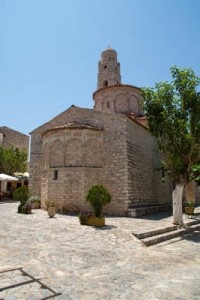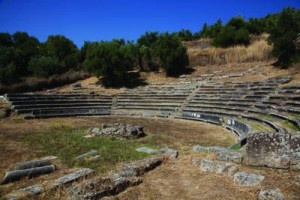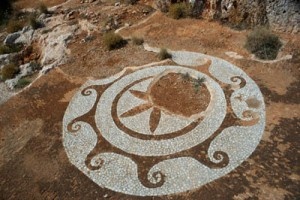Memories of Ancient Times – Holy Places
Route description
Your route starts in Gytheion. Your first stop is the ancient theatre, which dates back to Roman times and which came to light during the 1891 excavations. When in Gytheio, you have two options. You can either follow the road to Passava Castle, along the provincial road from Gytheio to Areopolis, where you can also see the remains of the ancient city Las, or you can follow the coastal road towards Kotronas. Alternatively, if you are travelling from Gytheio to Sparta, you can visit the remains of the ancient town of Aegies that flourished during the Minoan period and is located eight kilometers away from Gytheion. On your route to Kotronas, stop at a small village called Loukadika, located four kilometers away from the port of Kotronas, where you can see the ruins of the acropolis of ancient Tefthroni, scattered on a naturally fortified hill. From Loukadika, follow the provincial road from Kotronas to Areopolis until, five kilometers later, you reach the ruins of the ancient city Pyrihos. From there, follow the provincial road from Hosiari to Gerolimenas until you reach your final destination which is no other than the temple of Poseidon in Tainaro bay.
Information for visitors
Despite the fact that there are signs defining their location, the archaeological sites of the area are not clearly delimited and lack information material. You should be particularly careful when climbing to the Tefthroni acropolis. If you decide to have a close look at the Roman mosaic at Tainaro bay, you should be careful when following the natural path round it. The lighthouse of Tainaro can also be included in this hike. If you decide on following the road that leads to Tainaro, make sure you have enough gasoline. The last petrol station before Tainaro is in Gerolimenas.
Recreation information
Take a break and visit the beautiful beaches of Kotronas and the picturesque port of Agios Kyprianos (Saint Cyprian) from where rosso antico marble, dug out of the quarries of the area, used to be transported. Before arriving at Tainaro, turn into the direction of Marmari and enjoy a swim at a fully organized beach. For your accommodation, there are guest houses in the areas of Kotronas, of Gerolimenas and of Marmari.
Inhabited since ancient times, the peninsula of Mani has preserved the remains of ancient settlements and cities until today. On this route, you have the opportunity to travel into history and myth, to follow in the footsteps of Pafsanias to ancient Pyrrichos and the ruins of ancient Tefthroni, while the path to Tainaro will take you to the sanctuary of Poseidon and the gate to the Underworld.
Point of Interest A
Gytheio in antiquity
According to myth, the city was founded by Apollo and Hercules, a god and a demigod, after whom it takes its name. In antiquity and during Roman times, it was the commercial and administrative centre of the Common of Free Laconians. During the Roman period, the theatre of the city, the acropolis, the public baths, temples and several richly decorated houses with beautiful mosaics were constructed and the city was adorned with ornate statues. The devastating earthquake of 375 AD marked the beginning of the end for the city and led to its gradual abandonment. During the Roman period, a precious stone called krokeatis was exported from the port of Gytheio. Krokeatis stone is only found in Mani and is used for the decoration of monuments and temples worldwide even today.
Point of interest B
Gytheio – Roman theatre
The ancient theatre is located in the northern part of the city. It dates back to Roman times (2nd century AD) and was excavated in 1891. It is constructed with local whitish marble and has twelve rows of seats and five stairways. In the centre of the orchestra, there is a well that was dug at a later time.
Point of interest C
Loukadika – Acropolis of ancient Tefthroni

In the small village Loukadika, located 4 kilometers away from the port of Kotronas there are the ruins of the acropolis of ancient Tefthronis, scattered in a naturally fortified hill. According to Pafsanias, the ancient city was named after the Athenian settler Tefthras and had two citadels, one on the peninsula called Skopa and another one at the castle of Loukadika. In Skopa, there is a beautiful beach with a small church dedicated to Agios Nikolaos (St. Nicholas) , which, according to tradition, was built at the place where Issoria Artemis was worshipped.
Point of interest D
Pyrrichos
From Loukadika, continue on the provincial road from Kotronas to Areopolis. After 5 kilometres you come across the ruins of the ancient city Pyrrichos, mentioned in Pafsanias’ works. What is special about this small village is the fact that it has been continuously inhabited since ancient times. There, you can see numerous monuments extending all around the area that starts from the acropolis down to the foot of the hill.
Point of interest E
Tainaro – Sanctuary of Tainarios Poseidon – A Roman mosaic
The Sanctuary of Poseidon in Tainaro was the religious centre of the Common of Free Laconians. At this sanctuary, Neptune was not worshiped as god of the sea but as god of the Underworld. The Gates to the Underworld were said to be here, guarded by the terrible Kerveros, while according to myth, this is the place from where Iraklis (Hercules) and Orpheas (Orpheus) descended to the Underworld. In the same area, near the temple of Poseidon and along the path that leads to the lighthouse of Tainaro, there is an interesting Roman mosaic.


